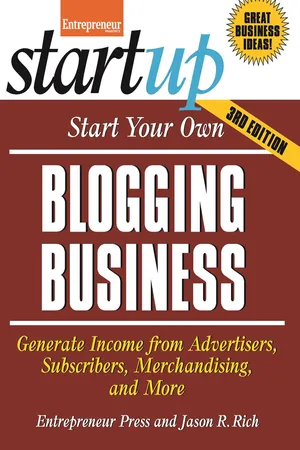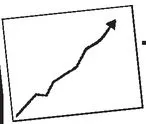![]()
1
Planning and Creating Your Blog
First, think carefully about what you want to say and what information you want to communicate via your blog. Make sure you have enough content to share over the long term, and will be able to regularly update your blog with fresh, engaging, and relevant content.
dp n="21" folio="2" ?Next, consider who your target audience will be. Then, figure out the best way to convey your information to your audience, and determine if you’ll primarily use text, photos, video, audio, computer graphics, and/or other multimedia content.
Think about how much technological knowledge you have, and how much time and money you want to invest in developing and producing your content. Once you’ve considered all of these important elements, you’ll be in a much better position to begin planning and creating what will hopefully become a successful blog. Plus, you’ll be able to determine which service you’ll use to host your blog, and be able to discover effective ways to promote it.
With thousands of new blogs being published each and every day, plus many being taken offline or simply abandoned in cyberspace, it’s impossible to calculate an accurate figure as to the number of blogs that actually exist in the blogosphere at any given moment. That being said, let’s take a quick look at how many blogs are hosted by some of the internet’s most prominent blog-hosting services as of April 2013:
• Tumblr—191.7 million
• Wordpress.com—65 million
• LiveJournal—62.6 million
• Weebly—12 million
• Blogster—583,000
• Blogger.com—1.2 billion
There are also many more mainstream blogging and online social networking services that host blogs, vlogs, and podcasts, such as Facebook, Twitter, YouTube, Vimeo, Vine, Pinterest, and Instagram, so the actual number of blogs available right now on the internet is well into the multi-billions.
One of the reasons why blogging has become so incredibly popular as a communications medium is because anyone can do it, and the startup costs are minimal. Using a blog, creative and charismatic people are able to bypass the usual corporate content publishers—such as magazines, newspapers, music record labels, TV networks, and radio stations—and deliver content directly to their audiences via the web.
Stat Fact
According to WordPress.com, it hosts more than 65 million blogs. More than 500,000 new posts are added to these blogs daily, and they’re read by more than 329 million people per month. These people generate in excess of 25 billion page views per month.
If you haven’t allowed yourself to wander beyond your usual favorite websites, you’ll be surprised to find that the number of online journals, photo albums, music galleries, artist portfolios, and other personal sites have exploded in number. Plus, you can find blogs, vlogs, and podcasts that cover every topic imaginable. As a result, new and original content is flooding the web, which has resulted in a true online renaissance.
This book will help you understand the significance of the blogging phenomenon, and more importantly, show you how people from around the world are using blogging to circumvent commonly accepted publishing procedures, and keep the profits generated from their own work, while also maintaining 100 percent creative control over their content.
The material presented within this book is designed around a five-step process. These steps include:
Step 1: Planning your blog
Step 2: Publishing your blog
Step 3: Managing your blog
Step 4: Promoting your blog
Step 5: Profiting or otherwise benefitting from your blog
Several chapters of this book detail what’s involved in each step of the overall blogging process. Keep in mind, these steps are equally important and must be given proper time and consideration. Also, some of the steps required will vary based on the type of blog you plan to create. For example, the steps involved in creating and publishing a text-based blog are different from what’s involved in producing a vlog or podcast.
“Engagement” Is All About Getting People Involved with Your Blog
One buzzword that’s used often these days is engagement. It refers not just to the quality of content that’s published online, but also to the level of interaction that the content generates from its audience. For example, a blog would be considered to have a high level of engagement if those who read it also post their own comments and/or share blog posts with their other online friends via Facebook or Twitter.
So, as you’re developing your blog and creating content, think in terms of how to make it highly engaging so that you can develop an interactive online community around your content. This will help you retain your existing audience and continuously expand the number of people who read your blog.
The urge to publish your work can be hard to resist, and once you get started as a blogger, you’ll discover the process is fun, rewarding, and also addicting. However, you don’t want to rush the process, especially the early planning stages. Once you decide to create a blog, the next step is to come up with an amazing topic to write about—one that will allow you to keep creating new, interesting, engaging, and innovative content (blog entries) on an ongoing basis.
Once you’ve chosen your topic, it’s important to develop an overall goal for your blog. You must truly understand the blog’s purpose and what you want to get out of it. At the same time, you need to clearly define your blog’s target audience, then develop content that caters specifically to that audience. All this needs to be part of your blog planning process, but more on that later.
As with any business, success is impossible without a solid foundation. Take your time with each and every step. Do your research, and think about the long-term ramifications of everything you do. At the same time, keep considering your overall blogging objectives, and make sure your actions will help you achieve them.
While there’s no limit to how much money you can earn running a successful and popular blog, it’s important to have realistic expectations. Chances are, you won’t become a millionaire, and blogging isn’t a get-rich-quick scheme. Truly successful bloggers often use their blog as a way to better communicate with customers and clients, or as a sales and marketing tool for their businesses. It’s not created to generate revenue on its own.
If you’re creating a blog as a business venture with hopes it will generate profits, this requires a lot of planning and promotion, because you’ll need to build and maintain an extremely large and dedicated following for the blog before it will generate any serious revenue.
In fact, self-publishing and self-promoting any type of work can be a bit of a challenge. While it won’t cost you a fortune to create and publish a successful blog that generates revenue, it will require that you put in serious work—not just creating, publishing, managing, and promoting the blog, but also overseeing the business side of the online venture as well.
Stat Fact
As of early 2013, more than 60 percent of all businesses maintain some type of blog.
dp n="24" folio="5" ? Smart Tip
If you’re launching a blog as a standalone business, you’ll need to establish your business entity properly from the start. File the appropriate paperwork, set up bank accounts, and lay the foundation for the business’s infrastructure accordingly.
Once your blog begins generating revenue, either from your audience or advertisers, you’ll need to handle the same business-related tasks as you would for any type of business, such as bookkeeping and paying taxes. In later chapters, we’ll focus on specific ways to generate revenue with your blog and how to transform it into a profit-generating venue (as opposed to a nonpaying hobby).
Before you start calculating all the riches you’ll be earning as a blogger, let’s spend a few minutes exploring what a blog, vlog, podcast, and microblog actually are. After all, you need to determine if this is what you want to do, what approach you want to take, and whether you have the wherewithal to do it right.
What Is a Blog?
The term “blog” comes from combining the words “web” and “log,” which was used for a short time to describe websites that published a running archive of dated entries, sort of like a digital diary that was displayed in chronological order. The techno-geeks that created the first “web logs” coined the term “weblog,” which ultimately evolved into the term “blog.”
The word “blog,” as a noun, can describe a regularly updated, primarily text-based website with individual, dated posts that are displayed chronologically. This is a traditional blog. Of course, today’s traditional blogs can also incorporate photos, videos, audio, and graphics, but they’re primarily text-based, and use a standard format for each entry.
The word can also be used as a verb, as in “to blog,” meaning to actively submit posts to a website, which is also referred to as “blogging.” The people who run blogs are known as “bloggers,” and the whole collection of all the internet’s blogs is known as the “blogosphere.”
Stat Fact
According to Worldmeters (www.worldometers.info/blogs), the total number of individual blog posts created and published per day is more than 1.8 million.
The anatomy of a traditional, text-based blog is nothing more than a basic website with a bunch of dated entries. All of the blogging services that host blogs allow bloggers to customize the look of their blog, by choosing text colors, fonts, and an overall layout or design. Many use professionally created templates that can be fully customized but that require no programming to use.
Beyond traditional blogs, there are also vlogs, podcasts, and microblogs. A vlog is a collection of videos, recorded and edited by the vlogger. Instead of using text, the vlogger stars in their own videos, and often simply looks into the camera and talks to their audience. You’ll find many popular vloggers on YouTube. Some have become popular internet personalities with huge followings.
Thanks to Twitter, and services like Facebook and Google+, millions of people have gotten hooked on microblogging. Instead of writing lots of text for a traditional blog, or recording videos for a vlog, they simply update their microblog feed with ongoing entries which are no longer than 140 characters in length (about one sentence long).
Meanwhile, for people who don’t like to write, services like Instagram allow people to upload images and include an optional text-based caption, keywords, and location to a photo.
For obvious reasons, microblogging is the easiest to do and requires the least amount of time and effort. Yet there are microbloggers with millions of followers who use their Twitter feed, for example, to promote their company, products, services, or themselves very successfully.
Many individuals as well as companies often use a combination of online activities to achieve their goals. For example, they’d ...




